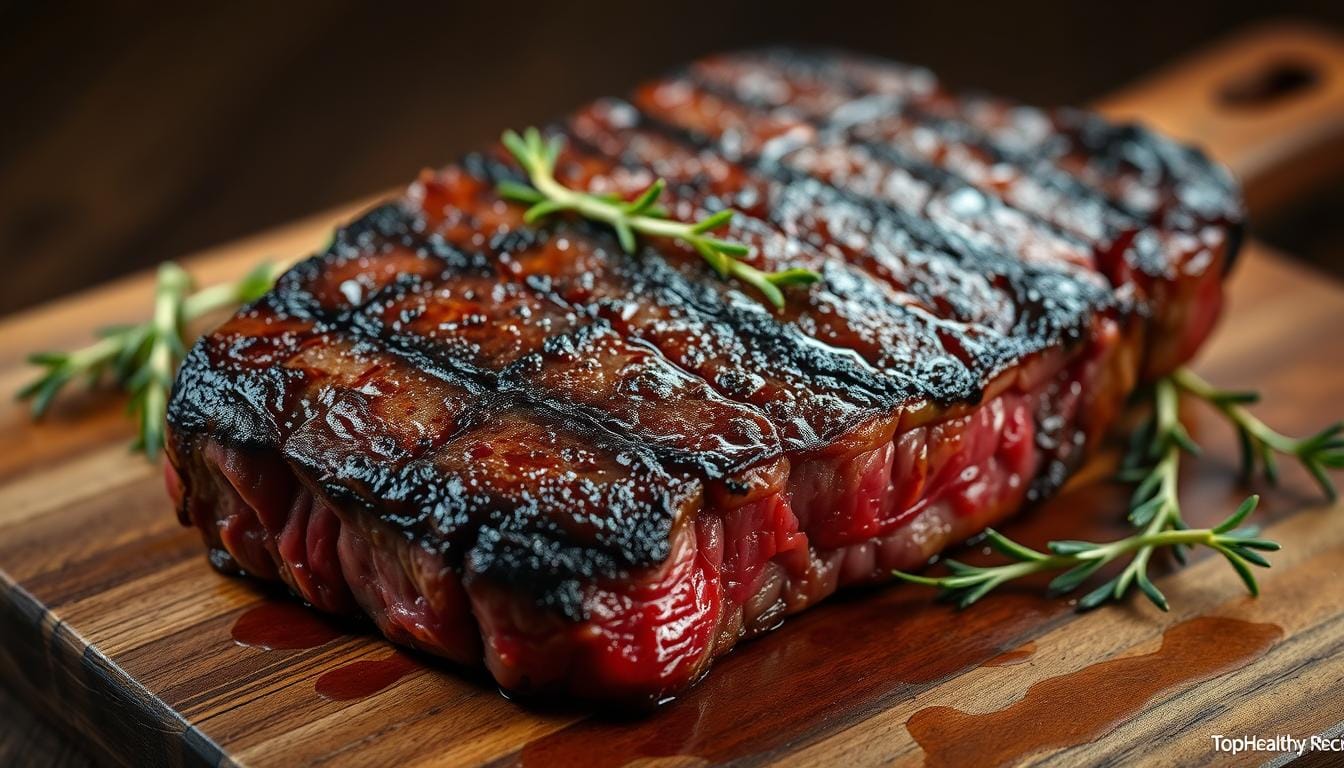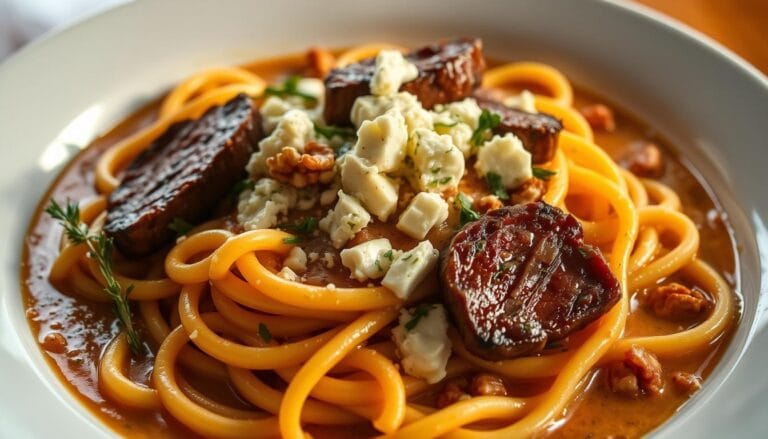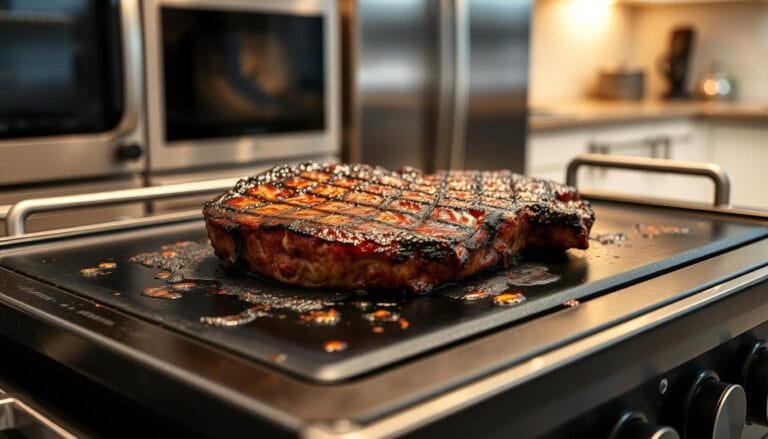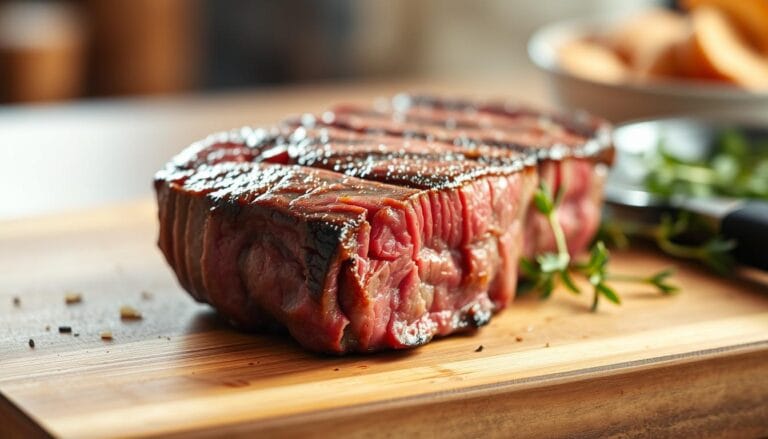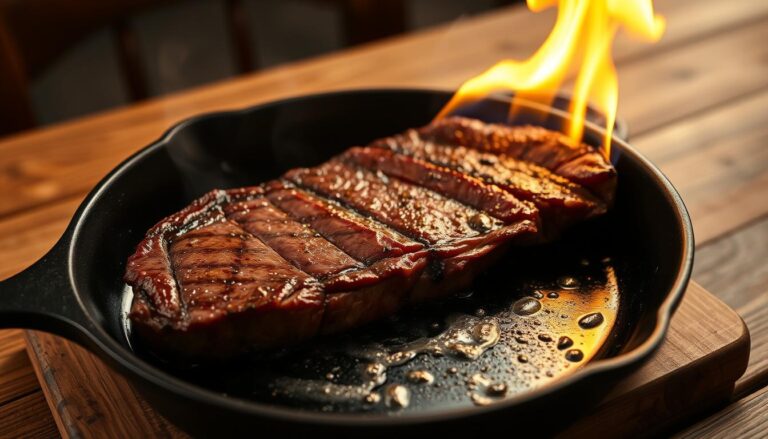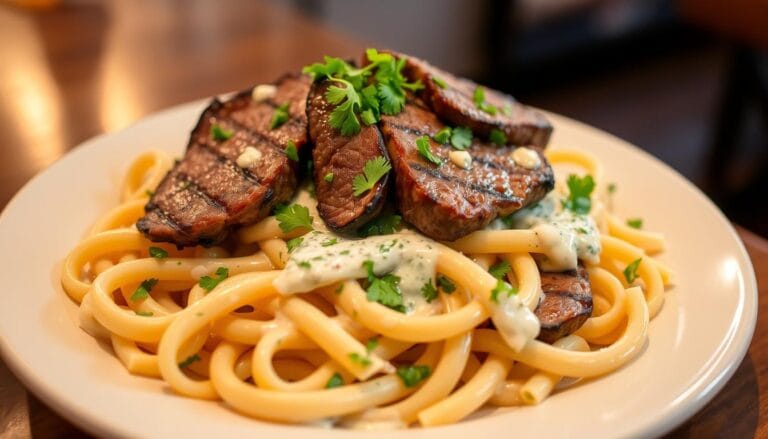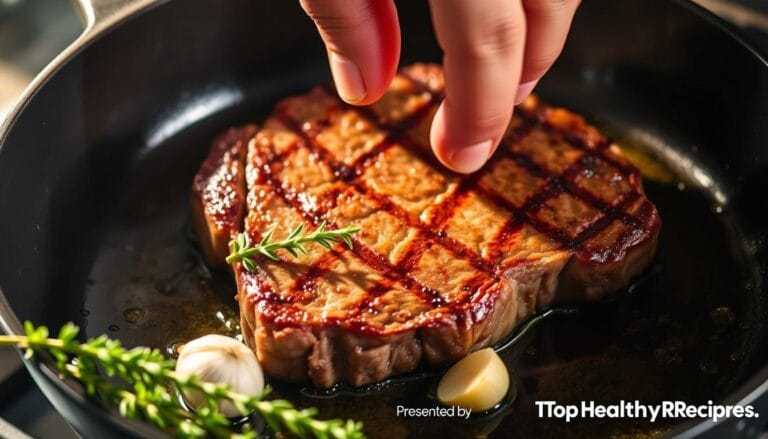What Is Coulotte Steak? Why This Cut Deserves a Spot on Your Grill
Table of Contents
What Is Coulotte Steak? Why This Cut Deserves a Spot on Your Grill
Have you tried beef coulotte yet? It’s not as well-known as ribeye or sirloin, but it’s becoming more popular. Coulotte steak is loved by chefs and home cooks for its rich taste and soft texture.
So, what’s so special about coulotte steak? It comes from the top sirloin, which is known for its marbling. This marbling makes the steak taste better and feel softer. As you learn more about coulotte steak, you’ll see how versatile it is and how it goes well with different flavors.
Key Takeaways
- Understanding the characteristics of coulotte steak
- Learning why coulotte steak is gaining popularity
- Discovering the best cooking methods for coulotte steak
- Exploring flavor profiles that complement coulotte steak
- Tips for selecting and preparing coulotte steak
What Is Coulotte Steak?
Ever wondered about the world of food? You might have heard of “coulotte steak.” It’s a beef cut that’s getting more popular for its great taste and soft texture. Let’s dive into what makes coulotte steak special.
Definition and Origin
Coulotte steak comes from the top sirloin’s cap, known for being tender and flavorful. It’s also called the sirloin cap or picanha in Brazilian cooking. The name “coulotte” comes from French, meaning a cut from the animal’s lower back.
In France, it’s prized for being leaner than other steaks. In Brazil, the picanha is a key part of churrasco grilling. It’s seasoned and grilled to perfection.
“The picanha, or coulotte, is a chef’s dream. It offers the perfect balance of tenderness and flavor, making it ideal for a variety of cooking techniques.” – Chef’s Insight
Characteristics of Coulotte Steak
Coulotte steak is known for its triangular shape and a fat cap on one side. This fat cap adds to its rich taste. The meat has moderate marbling, which makes it tender and juicy when cooked.
| Characteristics | Description |
|---|---|
| Shape | Triangular |
| Fat Cap | Present on one side |
| Marbling | Moderate |
| Texture | Tender |
| Flavor Profile | Rich, beefy |
The mix of its texture, flavor, and fat cap makes coulotte steak versatile and sought-after. It’s great for grilling, pan-searing, or oven-roasting, promising a top-notch meal.
Knowing about coulotte steak’s traits is key to picking and cooking it right. Its unique qualities and rich taste explain why it’s a hit among steak lovers.
How Is Coulotte Steak Different From Other Cuts?
Coulotte steak is a standout in the beef world. It offers a unique mix of flavor and tenderness. Knowing these differences helps when choosing meat for recipes and cooking.
Comparison to Sirloin
Coulotte steak is a part of the sirloin, the cap. It’s tender and flavorful, often better than the main sirloin. The main differences are in tenderness, fat, and taste.
Tenderness: Coulotte steak is more tender than regular sirloin steaks. This is because it has less connective tissue.
Fat Content: It has better marbling, making it juicier and tastier.
“The coulotte steak, being the cap of the sirloin, offers a more intense beef experience due to its marbling and tenderness,” says a renowned chef.
| Characteristics | Coulotte Steak | Sirloin Steak |
|---|---|---|
| Tenderness | High | Moderate |
| Fat Content | Well-marbled | Less marbling |
| Flavor | Rich, intense | Mild |
Comparison to Flank and Skirt Steak
Coulotte steak is different from flank and skirt steak. Flank and skirt steaks are leaner and need careful cooking. Coulotte steak is fattier and easier to cook.
Cooking Methods: Flank and skirt steaks are best cooked quickly over high heat. They’re sliced against the grain for tenderness. Coulotte steak can be grilled or oven roasted and is tender enough to be sliced with the grain.
When choosing between these cuts, think about cooking method and texture. For a tender, flavorful steak with less fuss, coulotte might be the best choice.
Popularity and Trends in the U.S.
Coulotte steak is now a hit in America, thanks to restaurants and home cooks. It was once a secret among butchers. Now, it’s loved by many for its rich taste and versatility.
Rise in Restaurants
Steakhouses and farm-to-table places love coulotte steak. It’s priced well, unlike ribeye or filet mignon. Chefs praise it for its flavor and how it can be cooked in many ways.
Key Factors in Coulotte’s Restaurant Success:
- Unique flavor profile
- Competitive pricing
- Versatility in preparation methods
Home Cooking Trends
More Americans are trying coulotte steak, thanks to Brazilian churrasco. Food blogs, cooking shows, and social media have helped. They make it easy for home cooks to try new cuts.
| Trend | Description | Impact |
|---|---|---|
| Brazilian Churrasco Influence | Introduction to coulotte steak as ‘picanha’ | Increased awareness and popularity |
| Social Media and Food Blogs | Sharing recipes and cooking techniques | Encouraged experimentation among home cooks |
| Cooking Shows | Demonstrating various cooking methods | Enhanced understanding of coulotte’s versatility |
Now, coulotte steak is a favorite in restaurants and homes. It offers a tasty and unique dining experience for everyone.
How to Select High-Quality Coulotte Steak
To enjoy the best coulotte steak, you need to know what to look for. Choosing a high-quality cut involves understanding several key factors. These factors include flavor, tenderness, and the overall dining experience.
Look for Marbling and Color
Marbling is key to a great beef coulotte. It’s the fat that’s spread throughout the meat. This fat makes the steak tender, juicy, and flavorful. Look for a cut with visible marbling.
The color of the steak is also important. Choose a steak with a bright cherry-red color. Avoid steaks with gray or brown discoloration. These colors can mean the steak is old or not handled well.
Choosing the Right Thickness
The thickness of your coulotte steak matters. Thicker cuts (1-1.5 inches) are best for grilling. They get a nice char on the outside and stay juicy inside.
Thinner cuts are better for quick-cooking methods like pan-searing. Think about how you plan to cook your steak when choosing its thickness.
Also, consider the USDA grade of the steak. Prime, Choice, and Select are common grades. Prime has the most marbling and tenderness, while Choice is high quality but less marbled. Select is leaner and less tender. Your choice depends on what you prefer in tenderness and flavor.
When looking for coulotte steak, you have several options. Specialty butchers, high-end grocery stores, and online meat purveyors often have it. Look for organic or grass-fed options if you prefer. Don’t be afraid to ask your butcher about the steak’s origin and quality. They can give you valuable insights to help you choose.
Preparing Coulotte Steak for Cooking
Before cooking your coulotte steak, it’s key to prepare it well. This brings out its full flavor and tenderness.
Preparation includes two main steps. First, gather the right tools and utensils. Second, choose or make the perfect marinade or seasoning blend.
Essential Tools and Utensils
To get your coulotte beef ready, you’ll need some basic tools. A sharp knife is essential for trimming fat, if needed. A sturdy cutting board is great for preparing the steak.
A meat thermometer is vital for checking the steak’s doneness. Tongs are useful for handling the steak, keeping it juicy.
- A sharp knife for trimming
- A cutting board for preparation
- A meat thermometer for precise doneness
- Tongs for safe handling
- Optional: a meat mallet for tenderizing thicker cuts
For advanced cooking, think about using a vacuum sealer for sous vide or a marinade injector for better flavor.
Marinades and Seasonings
The right marinade or seasoning can make your coulotte steak amazing. Simple mixes like salt, pepper, and garlic are classic. But, adventurous blends with herbs, spices, acids, and oils can add depth.
Marinating not only adds flavor but also tenderizes the meat. It breaks down proteins with acids like vinegar or citrus. This makes the meat tender and flavorful.
Marinating times range from 2 to 24 hours, based on the marinade’s strength and your taste. Dry brining with salt is another method that boosts flavor and texture.
“The art of marinating is about balance; too little, and the flavor won’t penetrate; too much, and the meat becomes overly acidic.”
Season your steak at the right time during cooking. This maximizes flavor without burning herbs or spices.
Cooking Methods for Coulotte Steak
To enjoy your sirloin coulotte steak at its best, mastering a few key cooking techniques is essential. Coulotte steak, with its rich flavor and tender texture, can be prepared in various ways. This brings out its full flavor and texture.
Grilling Techniques
Grilling is a favorite way to cook coulotte steak. It adds a smoky flavor and a nice char to the outside. You can use direct or indirect heat, depending on the steak’s thickness and your desired doneness.
For direct grilling, preheat your grill to high heat, between 450-500°F. This method is best for thinner cuts, as it cooks the steak quickly. It also gives a nice sear on the outside. To get appealing grill marks, rotate the steak 90 degrees after a couple of minutes on the first side.
- Preheat grill to 450-500°F for direct grilling.
- Rotate steak 90 degrees to achieve crosshatch grill marks.
- Let the steak rest for a few minutes after grilling to allow juices to redistribute.
A common mistake when grilling is moving the steak too frequently. This can squeeze out juices and make the steak tough. Instead, let it cook undisturbed for a couple of minutes on each side.
Oven-Roasting Tips
Oven-roasting is another excellent way to cook coulotte steak, great for thicker cuts. The sear-then-roast method works well: start by searing the steak in a hot cast-iron skillet. Then, finish it in the oven.
| Doneness Level | Oven Temperature (°F) | Internal Temperature (°F) |
|---|---|---|
| Rare | 300 | 120-130 |
| Medium Rare | 300 | 130-135 |
| Medium | 300 | 140-145 |
For thicker cuts, try the reverse sear method. Slow-roast the steak in the oven until it reaches your desired doneness. Then, sear it in a hot skillet to add a crust. This method ensures even cooking and can result in a more tender steak.
Combining sous vide with a quick sear can also produce exceptionally tender and precisely cooked coulotte steak. This method involves cooking the steak sous vide to the exact doneness you prefer. Then, quickly sear it in a hot skillet to add a flavorful crust.
Perfecting the Doneness of Coulotte Steak
Cooking your coulotte steak just right is key for a great meal. You need to know the right tools and methods to cook it to your taste.
Using a Meat Thermometer
A meat thermometer is essential for cooking coulotte steak perfectly. It helps you avoid guessing, which is important with a steak that can be different sizes. There are many types of thermometers, like digital and analog ones.
To use it right, put the thermometer in the thickest part of the steak. Make sure it’s not near any bone or fat.
Internal Temperature Targets:
- Rare: 125°F
- Medium-rare: 135°F
- Medium: 145°F
- Medium-well: 150°F
- Well-done: 160°F
Visual Cues for Doneness
You can also check doneness by looking at the steak’s color and feel. A rare steak will be soft and red inside.
Carryover cooking is another thing to think about. It’s when the meat gets hotter after you take it off the heat. So, take it off 5-10°F before it reaches your target. Letting the steak rest for 5-10 minutes after cooking is also key. This makes it juicy and flavorful.
Using a meat thermometer and knowing how to check doneness visually helps a lot. Whether you like your steak rare or well-done, these tips will make your beef coulotte taste amazing every time.
Serving Suggestions for Coulotte Steak
Serving coulotte steak is all about mixing flavors and textures for a great meal. You can make it even better by choosing the right sides and how you present it.
Best Sides to Pair With Coulotte
Choosing sides for coulotte steak is about finding the right balance. Try roasted potatoes, grilled vegetables, or creamy mashed potatoes for a classic taste. For something new, think about chimichurri-dressed grains, blue cheese salads, or truffle-infused sides. These add a fresh touch that cuts through the steak’s richness.
| Side Dish | Description | Flavor Profile |
|---|---|---|
| Roasted Potatoes | Crispy on the outside, fluffy on the inside | Earthy, savory |
| Grilled Vegetables | Seasonal vegetables grilled to perfection | Smoky, slightly charred |
| Creamy Mashed Potatoes | Rich and creamy, infused with garlic and herbs | Comforting, rich |
Creative Serving Ideas
How you present coulotte steak matters a lot. Slice it against the grain for tenderness and arrange it nicely. You can serve it family-style or on individual plates. Adding sauces like béarnaise or chimichurri can add flavor without overwhelming the steak.
For a unique twist, try Brazilian or Argentine-style presentation. These styles not only look great but also add to the cultural feel of your meal. Play with different garnishes and sides to find your favorite way to serve it.
Storing Leftover Coulotte Steak
Wondering how to store leftover sirloin coulotte steak? It’s important to keep it fresh for future meals. Proper storage helps keep the steak tender and flavorful.
Refrigeration Techniques
Cool the steak down quickly to stop bacteria from growing. Wrap it tightly in plastic wrap or foil, or use an airtight container. Vacuum sealing is also good to keep air out.
Keep the steak in the fridge at 40°F (4°C) or below. Leftover coulotte steak stays good for 3 to 4 days. Always check for spoilage before eating, like bad smells or mold.
| Storage Method | Description | Safety Precautions |
|---|---|---|
| Airtight Container | Store cooled steak in an airtight container. | Keep refrigerated below 40°F (4°C). |
| Plastic Wrap or Aluminum Foil | Wrap cooled steak tightly. | Prevent air exposure to avoid oxidation. |
| Vacuum Sealing | Remove air before sealing. | Store in refrigerator at consistent temperature. |
Reheating Tips
Reheating leftover coulotte steak needs care to avoid overcooking. Try the low-and-slow oven method: heat it in a 275°F (135°C) oven until warm. Or, use a sous vide for exact temperature control.
Don’t microwave it, as it can make the meat tough. Slice the cold steak thinly for salads or sandwiches. You can also make steak tacos, beef stroganoff, or steak and eggs for breakfast.
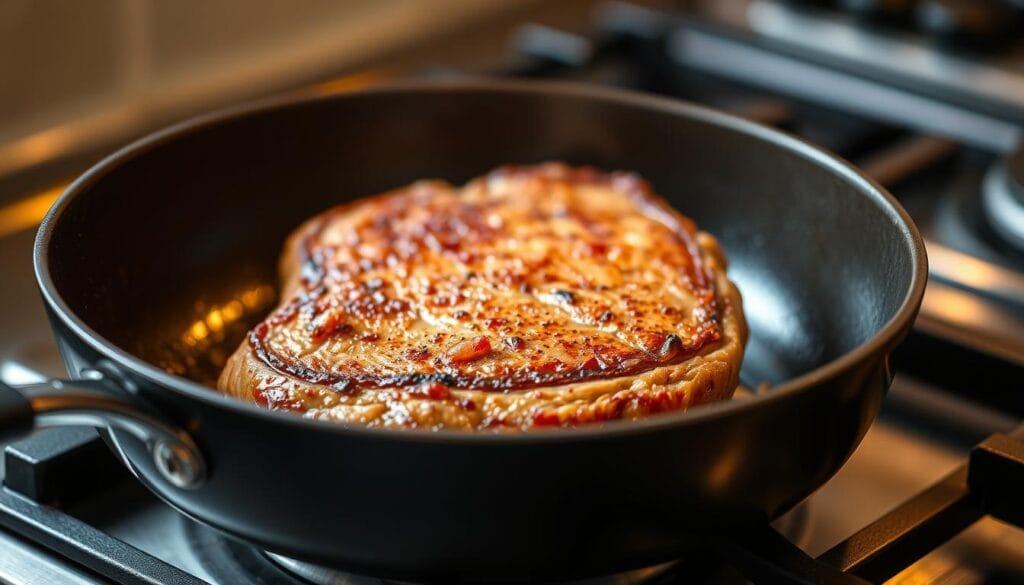
By following these tips, you can enjoy your leftover sirloin coulotte steak. It will stay tender and flavorful.
Nutritional Profile of Coulotte Steak
Knowing the nutritional value of Coulotte Steak is key for smart food choices. It’s packed with nutrients that can boost your diet.
Calories and Macronutrients
A 3-4 oz serving of Coulotte Steak has about 200-250 calories. It’s a top source of protein, with 25-30 grams per serving. The fat content is 10-15 grams, depending on trimming. Carbs are almost none, making it great for low-carb diets.
| Nutrient | Amount per 3-4 oz serving |
|---|---|
| Calories | 200-250 |
| Protein | 25-30g |
| Fat | 10-15g |
| Carbohydrates | Negligible |
Health Benefits of Eating Coulotte
Coulotte Steak is tasty and good for you. It’s full of high-quality protein for muscle repair and growth. It also has lots of B vitamins, like B12, which is key for nerves and blood cells.
The steak is rich in iron, zinc, and selenium. Iron helps red blood cells, zinc boosts immunity, and selenium fights off free radicals. Eating Coulotte Steak helps you get these important minerals.
Remember, the nutritional benefits of Coulotte Steak can change based on how you cook it and what you add. Trimming the fat cap makes it leaner. This makes Coulotte Steak flexible for different diets, from high-protein to balanced eating.
Coulotte Steak in Cultural Contexts
Exploring coulotte steak takes you on a journey through different cultures. Each culture has its own way of preparing it, showing off local tastes and traditions.
Regional Variations in Preparation
In Brazil, it’s called picanha and is the main attraction at churrasco barbecue. It’s seasoned with salt and grilled to perfection. In Argentina, it’s grilled over an open flame with just salt, letting the beef’s natural flavors shine.
French cuisine, where it gets its name, might serve it with classic sauces. This adds to its rich flavor.
Coulotte steak’s preparation varies a lot across cultures. For example, in some Asian dishes, it’s marinated in soy sauce and ginger. In Mediterranean cuisine, it’s seasoned with herbs like thyme and rosemary.
The Role of Coulotte in American Cuisine
In the United States, coulotte steak has become more popular. American chefs have mixed international styles with their own twist. This has made coulotte steak a favorite in steakhouses and home kitchens.
The farm-to-table movement and the search for flavorful cuts have helped coulotte steak gain popularity. You can see this in dishes that mix American flavors with international touches. For instance, some restaurants serve it with a horseradish cream sauce, blending classic American tastes with a European flair.
Frequently Asked Questions About Coulotte Steak
Are you new to cooking coulotte steak? You might wonder about its tenderness and how to cook it just right. Coulotte steak, also known as sirloin coulotte steak, is loved for its rich flavor and tender texture when cooked well.
Tenderness of Coulotte Steak
Coulotte steak is tender but not as tender as some cuts. It’s more tender than flank or chuck but less tender than tenderloin. The tenderness of coulotte steak depends on how you slice it, cook it, and how done you like it.
Slicing against the grain is key for tenderness. Marinating can also make it more tender by breaking down its fibers. Some enjoy the firmer texture of coulotte steak for its “bite.”
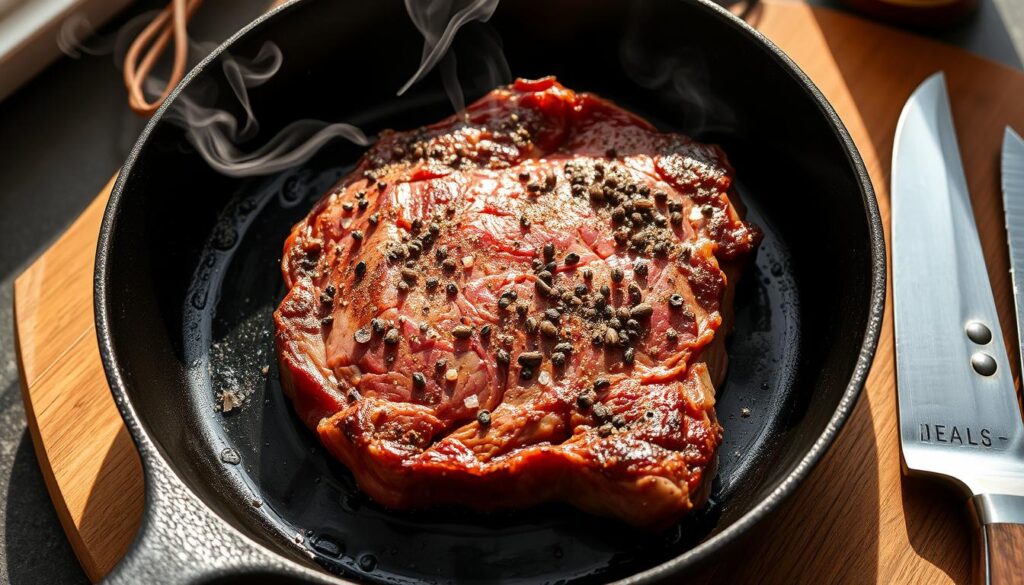
Cooking Coulotte Steak to Medium Rare
Coulotte steak is perfect when cooked to medium-rare. This means an internal temperature of 130-135°F after resting. Many experts say this is the best way to enjoy its tenderness and flavor.
To get medium-rare right, you can grill or oven-roast it. Using a meat thermometer helps make sure it’s cooked to the right temperature.
Other Common Questions
People also ask about coulotte steak’s other names, its price, and whether to remove the fat cap before cooking. It’s known by different names in different places, and its price can change based on quality and location.
- The fat cap on coulotte steak can be left on during cooking as it helps to keep the steak moist and adds flavor.
- Coulotte steak is generally priced competitively with other steak cuts, making it a good value for its flavor and tenderness.
Understanding these aspects of coulotte steak helps you appreciate its unique qualities and cook it to your liking.
Conclusion: Embrace the Deliciousness of Coulotte Steak
Now that you know about coulotte steak, it’s time to try it at home. This cut is known for its rich flavor and tender texture. It’s a favorite among chefs and home cooks because it’s so versatile.
Key Takeaways
Coulotte steak is special because of its marbling. This makes it taste better and feel softer. The best ways to cook it are grilling and oven-roasting. This keeps its juices in.
It’s also good for you, full of protein and vitamins.
Experiment with Coulotte Steak
Try different marinades, seasonings, and cooking methods. This will help you find your favorite way to cook coulotte steak. Whether you’re experienced or new to cooking, coulotte steak is a great choice.
Go to your local butcher or specialty market to find coulotte steak. Then, try a recipe that you think you’ll like.
FAQ
What is coulotte steak?
Is coulotte steak tender?
Can you cook coulotte steak medium-rare?
What is another name for coulotte steak?
How do you select a high-quality coulotte steak?
What are the best cooking methods for coulotte steak?
How do you achieve the perfect doneness when cooking coulotte steak?
What are some good sides to serve with coulotte steak?
How should leftover coulotte steak be stored and reheated?
What is the nutritional profile of coulotte steak?
For more cooking tips, stay connected with us. We also recommend the cookbook Skinnytaste Simple: Easy, Healthy Recipes with 7 Ingredients or Fewer
For more Recipes about Steak ?
Did You try our recipe ?
There are no reviews yet. Be the first one to write one.
